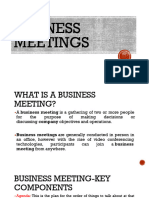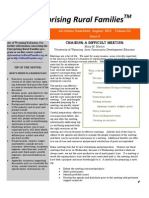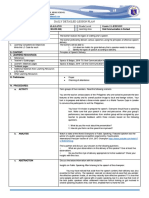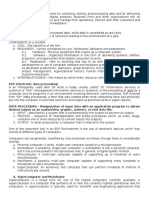Chair
Uploaded by
M'zelle HoudaChair
Uploaded by
M'zelle HoudaChairing a meeting
An important job of the Chairperson is chairing meetings. This information sheet looks at what Chairing a meeting involves, and how to do it. There are some useful tips and advice to help improve and develop your chairing skills. Prior House 6 Tilbury Place Brighton BN2 0GY Tel. 01273 606160 Fax. 01273 673663 info@resourcecentre.org.uk www.resourcecentre.org.uk
What makes a good Chair?
A good Chair helps the meeting to run smoothly and efficiently. They will make sure that:
l l l l
all the business is discussed everyones views are heard clear decisions are reached the meeting starts and finishes on time. always be thinking about the meeting overall, not just the topic under discussion. This can make it more difficult for you to participate in the discussions. always aim to draw a balance between hearing everyones views and getting through the business. never use their position as chair as an opportunity to put forward their views to the exclusion of others, or to dominate the meeting.
A good chair will also:
l
The Resource Centre also produces the following information sheets: The Secretarys role Taking Minutes The Agenda Organising an AGM
No one can do this without the co-operation and agreement of the whole meeting - the chair person is not a miracle worker! Everyone can learn how to chair well, it just takes a bit of thought and practice. You will get more confident with experience. Try watching how other people chair meetings, and seeing what works and what doesnt.
Do you need a Chairperson?
Some groups dont have a formal role of Chair, or a named Chairperson. However, even very small or informal meetings need some direction and organisation. You could decide to rotate this role. This has the advantage that it spreads the responsibility and gives everyone a chance to be involved with the running of the group. A potential disadvantage of rotating the Chair is that no one takes responsibility for the role, or that the same person always ends up chairing without a proper agreement about this. If you do decide to have a rotating Chair, work out collectively what is expected of them and agree from the end of each meeting who will Chair the next one. This gives them the opportunity to think about the meeting and their role in it.
They are all available on our website or from the Resource Centre
Published November 2007
Page 1
PTO
Page 2
Chairing a meeting
Before the meeting
To Chair a meeting well, you need to think about the meeting before you arrive at it. Ask yourself the following questions in advance of the meeting:
l l l l l l l
Why are you having the meeting? What end result do you want from it? What will you discuss at it? Do you want speakers? Do you need to get more information to inform the discussion? Do you want to ask someone to prepare an introduction? Do you want to distribute any information in advance of the meeting?
It isnt the Chairs job to figure all this out on their own. Work together with the Secretary and other Committee members. Find out what people want to discuss, and think about how you can raise issues in a clear and informed way.
Agenda
See the Resource Centre sheet The Agenda: a quick and easy guide to preparing an agenda An agenda is simply a list of the things you want to discuss in your meeting. As well as helping you plan, it is a useful way of making sure you cover everything you need to at the meeting. A clear agenda, with timings, really helps when you are chairing. Timing is important to the success of the meeting. Disorganised and unexpectedly long meetings can demoralise people. Productive meetings of 2 hours or less can be an experience which builds morale, and strengthens your organisation.
At the start of the meeting
You want everyone at the meeting to feel comfortable about speaking and putting their point of view. For a meeting to work well, everyone needs to feel welcome, included and informed. Here are a few tips:
l
Organise someone to welcome people as they arrive. Never let a new person sit ignored while everyone else chats. Make sure everyone has the agenda and any papers - put them on chairs, or give them to people at the door. Introduce yourself and other speakers at the start of the meeting. If it is a small meeting, ask everyone to introduce themselves. Sometimes it works well to get people to say a bit more about themselves as part of the introductions. Tell people what the meeting is about. Dont assume everyone knows as much as you do.
l l
Page 3
Chairing a meeting
How will your meeting be run?
Every Chair needs some guidelines about how the group wants their meetings to be run. It helps to set out some simple rules - these must be ones everyone accepts and is prepared to work with, or theyll be useless. Once youve got some rules agreed, it is much easier to chair the meeting, and people are less likely to take it personally when you ask them not to interrupt, or stop them from wandering off the topic. You need to work out the rules that suit your group, but here are some that are commonly used: -
Examples of meeting rules
l
Ask people to speak through the chair. This means putting your hand up if you want to speak, and waiting for the chair to say its your turn. Dont interrupt other people. Stick to the item on the agenda. Dont talk amongst yourselves. Respect other peoples views - dont groan or pull faces when someone else is speaking. Wait until theyve finished and then put your point of view calmly and politely. Keep contributions short and to the point. Start and finish the meeting on time.
l l l l
l l
Remember....
l
You will need to remind people of the meeting rules at each meeting. There may be new people there, and even regular attendees will forget. A group can take a while to get used to the meeting rules youve agreed. If it doesnt work perfectly first time, keep on trying.
Chairing the meeting
The key tasks of the Chair during the meeting are: 1. 2. 3. 4. Getting through the business on time Involving everyone Reaching decisions Dealing with difficult people
Here are some tips on each of these areas:-
PTO
Page 4
Chairing a meeting
1. Getting through the business
Its very frustrating for everyone if a meeting doesnt deal with the business it needs to, or if it drags on for hours. People leave feeling demoralised and irritated - and quite possibly wont come back.
Here are a few tips: l l l
Have a clear agenda with rough timings Briefly introduce each agenda item (or get someone else to). Never assume people know what youre talking about. Take time to go over the issues and explain why you are discussing them. Always keep an eye on the time, and move items on if necessary. Make sure youve got a watch, or can see a clock. Stick to the agenda item under discussion. If people try to raise other issues, acknowledge them, but dont get drawn in, eg Thats an important point which we can come back to later.... Stop private conversations and asides as soon as they start. Tell the meeting what decisions you are making and why - eg Im going to give this discussion another 5 minutes and then draw it to a close
l l
Remember:l
Dont use your position as an opportunity to impose your views. You are there to facilitate the meeting, not dominate it. Keep an overview - remember your role as Chair. Listen to other people. Make sure all view points get heard - including those you disagree with. Dont be under-assertive. Youve been given a role, and people will be looking to you. Dont be afraid of speaking out.
l l l
2.
Involving everyone
Have you ever been at a meeting where no one spoke out against a particular proposal, but you discover afterwards that lots of people didnt agree with it? This happens far too often, and means there will only be half-hearted support for the groups decisions. You want to hear everyones views, and make sure everyone is included and involved in the meeting. There are two sides to this:l
Restraining those who are over keen on the sound of their own voice. Encouraging those who are quiet, nervous, or new to meetings.
Page 5
Chairing a meeting
Ideally, you want an atmosphere where there can be genuine debate and discussion. People should be able to disagree with each other and listen to different opinions in a way that is constructive and moves everyone on. This takes time to develop, and requires the involvement of the whole group, but there are things the Chair can do to help:-
Some tips on involving people:l
If lots of people want to speak, keep a list of whose turn it is to speak next to remind you. Make sure people know you have noticed that they want to speak. Stop people from talking for too long. Be firm and consistent but not aggressive. If someone is going on endlessly, interrupt them and say something like thank you for your contribution, youve raised some interesting points. Im going to stop you there for the moment so other people can comment on this issue Give preference to people who havent spoken before. Say something like I know youve got your hand up, John, but Im going to take Mary first as she hasnt spoken yet. Give opportunities to everyone to put their point of view. Ask questions to draw people out, for instance Does anyone else have any thoughts on this issue? or Is there anyone who hasnt spoken yet who would like to say something? Try going round everyone in turn to get their views on a topic this only works in a small meeting. Stop people from interrupting. Step in immediately with, Hold on, let x finish what they have to say. Make sure you dont forget to come back to the person who interrupted when its their turn. Make sure you dont ignore people who have their hands up in favour of those who are interrupting. Listen carefully to what people are saying, and make sure their suggestions and considered by the meeting. Make sure people expressing unpopular or minority views get heard properly and arent intimidated out of saying what they think.
3.
Reaching decisions
Its easy for discussions to wander around and then drift away without any decision or action agreed. Or discussions get bogged down, with no one taking responsibility for finding a way through.
PTO
Page 6
Chairing a meeting
The Chair needs to keep an overview, and help the meeting to reach decisions. Dont worry if you cant do this straight away - its one of the most difficult bits of chairing, and it takes confidence and practise to do well.
A few tips:l l
Listen carefully to the discussion and jot down key points. At the start of a discussion, remind people what the issue is, and what decisions need to be made. See if you can pull together the points people are making and suggest a constructive way forward. For instance, you might begin It seems we agree that.... If there are two or three different points of view, try to summarise each one and present them clearly to the meeting. Before you move on to the next item, go over whats been agreed. This is a way of checking you did all agree the same thing, and helps the minute-taker to get a clear record. Before you move on, check that youve decided who will do whatever it is youve agreed on. If you dont, either nothing will happen, or the person who always does everything will end up with yet another task. Dont assume silence means agreement. Make sure people have been able to say what they think.
4. Dealing with difficult people
The Chair can have to deal with difficult people - the non-stop talker, or the know-alls, or those with a particular bee in their bonnet. There are no easy answers, but the general way you conduct the meeting will make a difference. Here are some tips. Remember that the majority of people at the meeting will be supporting your efforts.
l
Remind people of the meeting rules, and that everyone has agreed to these. Be firm and consistent - dont allow difficult people to get away with things and then come down hard on people you find easier. When two people get into a heated discussion, summarise the points made by each, then move the focus away from the individuals by asking what other people think about the issues. When someone keeps repeating the same point, assure them that their point has been heard, and then turn the discussion back to the group. If someone is continually criticising try to turn the question round to them, for instance what suggestions do you have for how this could be improved? or what would you do in this situation?
Page 7
Chairing a meeting
l
On rare occasions you may have to deal with someone who is really disruptive in a meeting, and wont listen to any of your helpful suggestions. If this happens, try asking the group for support - eg do people want to spend more time on this discussion or move on to the next topic? This will make it clear to the person involved that everyone, not just the chair person, wants to move on.
How did the meeting go?
It is always useful to get feed-back on how the meeting went. One way of doing this is to ask people at the meeting what they thought of it. You can do this at the end of the meeting. Just go round everyone in turn, asking them how they thought it went. You will get some useful feedback, and it makes everyone feel involved. This tends to work best with a small group that meets regularly, but can also be useful in other situations. If it is a big public meeting, you might want to have comment or suggestion forms for people to fill out at the end of the meeting.
After the meeting
l
Allow time after the meeting has finished to talk to new people, or follow up suggestions and contributions people made. Talk to your committee members about how the meeting went. Start thinking about the next meeting!
l l
You might also like
- The Ti-Mandi Window: A Time-Management Tool For Managers: John NichollsNo ratings yetThe Ti-Mandi Window: A Time-Management Tool For Managers: John Nicholls5 pages
- Chairing A Meeting: By: Afdhalina, S.Pd.I.,M.Hum100% (2)Chairing A Meeting: By: Afdhalina, S.Pd.I.,M.Hum27 pages
- Chairing Meetings: What Makes A Good Chair? Agenda100% (1)Chairing Meetings: What Makes A Good Chair? Agenda4 pages
- Essential Meeting Skills - Chair & Minute Taking100% (1)Essential Meeting Skills - Chair & Minute Taking24 pages
- In Company Intermediate Unit 3 Students BookNo ratings yetIn Company Intermediate Unit 3 Students Book7 pages
- 30 Important English Phrases For Business IntroductionsNo ratings yet30 Important English Phrases For Business Introductions7 pages
- English For Business: Useful Phrases To Use During A Business MeetingNo ratings yetEnglish For Business: Useful Phrases To Use During A Business Meeting3 pages
- Useful Business English Meetings PhrasesNo ratings yetUseful Business English Meetings Phrases11 pages
- Business English Negotiating Phrases Error Correction Pairwork PDFNo ratings yetBusiness English Negotiating Phrases Error Correction Pairwork PDF6 pages
- Effective Communication: Afendi Bin Zahari Muhammad Bahjatuddin Bin Mohd Idris100% (1)Effective Communication: Afendi Bin Zahari Muhammad Bahjatuddin Bin Mohd Idris11 pages
- Plain English, Please!: A Seminar-Workshop in Plain English (How To Write Readable Documents)No ratings yetPlain English, Please!: A Seminar-Workshop in Plain English (How To Write Readable Documents)29 pages
- Key Phrases For Interviews: A Book From The SeriesNo ratings yetKey Phrases For Interviews: A Book From The Series20 pages
- Lesson1-Making Small Talk in Business SettingsNo ratings yetLesson1-Making Small Talk in Business Settings21 pages
- Speech Transitions - Words and Phrases To Connect Your IdeasNo ratings yetSpeech Transitions - Words and Phrases To Connect Your Ideas9 pages
- Demelyn G. Alagano Grade 11-EDISON: Daily Detailed Lesson PlanNo ratings yetDemelyn G. Alagano Grade 11-EDISON: Daily Detailed Lesson Plan2 pages
- 25 Powerful Business English Presentation Phrases To Impress Your AudienceNo ratings yet25 Powerful Business English Presentation Phrases To Impress Your Audience3 pages
- Minnie's Sacrifice by Harper, Frances Ellen Watkins, 1825-1911No ratings yetMinnie's Sacrifice by Harper, Frances Ellen Watkins, 1825-191168 pages
- The Linguistics of Second Language Acquisition: Sar BoNo ratings yetThe Linguistics of Second Language Acquisition: Sar Bo10 pages
- Defining A Mentoring Relationship New MenteesNo ratings yetDefining A Mentoring Relationship New Mentees3 pages
- Republic of The Philippines Professional Regulation Commission ManilaNo ratings yetRepublic of The Philippines Professional Regulation Commission Manila4 pages
- Comparative Analysis - History of Architecture - Mayan, Aztec, IncaNo ratings yetComparative Analysis - History of Architecture - Mayan, Aztec, Inca8 pages
- Ge8076-Professional-Ethics-In-Engineering Question BankNo ratings yetGe8076-Professional-Ethics-In-Engineering Question Bank19 pages
- Garden Leave and Settlement Agreements Monaco SolicitorsNo ratings yetGarden Leave and Settlement Agreements Monaco Solicitors1 page
- Creating Developmental Questions: Session 4a: Learner GuideNo ratings yetCreating Developmental Questions: Session 4a: Learner Guide9 pages
- Developing Teamwork and Communication Skills in A MultidisciplinNo ratings yetDeveloping Teamwork and Communication Skills in A Multidisciplin4 pages
- Net-Analyser Na96 and Na96+: General InformationNo ratings yetNet-Analyser Na96 and Na96+: General Information31 pages
- Larry Klayman vs. Commie Girl Industries and Rebecca Schoenkopf Order To Dismiss100% (1)Larry Klayman vs. Commie Girl Industries and Rebecca Schoenkopf Order To Dismiss9 pages
- McGarty 1988 - Categorization, Accentuation and Social JudgmentNo ratings yetMcGarty 1988 - Categorization, Accentuation and Social Judgment11 pages
- The Ti-Mandi Window: A Time-Management Tool For Managers: John NichollsThe Ti-Mandi Window: A Time-Management Tool For Managers: John Nicholls
- Chairing Meetings: What Makes A Good Chair? AgendaChairing Meetings: What Makes A Good Chair? Agenda
- 30 Important English Phrases For Business Introductions30 Important English Phrases For Business Introductions
- English For Business: Useful Phrases To Use During A Business MeetingEnglish For Business: Useful Phrases To Use During A Business Meeting
- Business English Negotiating Phrases Error Correction Pairwork PDFBusiness English Negotiating Phrases Error Correction Pairwork PDF
- Effective Communication: Afendi Bin Zahari Muhammad Bahjatuddin Bin Mohd IdrisEffective Communication: Afendi Bin Zahari Muhammad Bahjatuddin Bin Mohd Idris
- Plain English, Please!: A Seminar-Workshop in Plain English (How To Write Readable Documents)Plain English, Please!: A Seminar-Workshop in Plain English (How To Write Readable Documents)
- Key Phrases For Interviews: A Book From The SeriesKey Phrases For Interviews: A Book From The Series
- Speech Transitions - Words and Phrases To Connect Your IdeasSpeech Transitions - Words and Phrases To Connect Your Ideas
- Demelyn G. Alagano Grade 11-EDISON: Daily Detailed Lesson PlanDemelyn G. Alagano Grade 11-EDISON: Daily Detailed Lesson Plan
- 25 Powerful Business English Presentation Phrases To Impress Your Audience25 Powerful Business English Presentation Phrases To Impress Your Audience
- Minnie's Sacrifice by Harper, Frances Ellen Watkins, 1825-1911Minnie's Sacrifice by Harper, Frances Ellen Watkins, 1825-1911
- The Linguistics of Second Language Acquisition: Sar BoThe Linguistics of Second Language Acquisition: Sar Bo
- Republic of The Philippines Professional Regulation Commission ManilaRepublic of The Philippines Professional Regulation Commission Manila
- Comparative Analysis - History of Architecture - Mayan, Aztec, IncaComparative Analysis - History of Architecture - Mayan, Aztec, Inca
- Ge8076-Professional-Ethics-In-Engineering Question BankGe8076-Professional-Ethics-In-Engineering Question Bank
- Garden Leave and Settlement Agreements Monaco SolicitorsGarden Leave and Settlement Agreements Monaco Solicitors
- Creating Developmental Questions: Session 4a: Learner GuideCreating Developmental Questions: Session 4a: Learner Guide
- Developing Teamwork and Communication Skills in A MultidisciplinDeveloping Teamwork and Communication Skills in A Multidisciplin
- Larry Klayman vs. Commie Girl Industries and Rebecca Schoenkopf Order To DismissLarry Klayman vs. Commie Girl Industries and Rebecca Schoenkopf Order To Dismiss
- McGarty 1988 - Categorization, Accentuation and Social JudgmentMcGarty 1988 - Categorization, Accentuation and Social Judgment

























































































